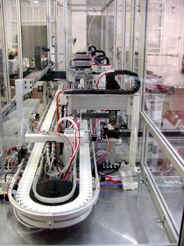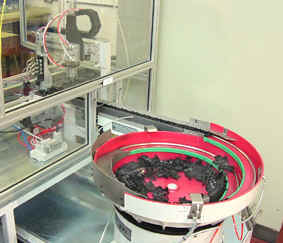|
Pallet
Based Assembly System for Plastic Parts
TQC have performed a number of sophisticated
pallet based automatic assembly and test projects for several demanding
applications. The system shown here was designed and engineered
for the automation of a glove box latch assembly for a high volume
automotive manufacturer. The latch can be produced in different
formats for different applications, hence a modular automation approach
has been adopted. The production volumes are large and hence the
machine cycle time is relatively short. The system was supplied
to Southco Manufacturing winners of the Management Today 2001 Best
Factory Award.
TQC have provided multi station industrial automation
production lines and robot workstations in different applications,
ranging from automotive parts manufacture, transfer of green state
ceramic components, medical device assembly and precision automation
at high speeds.
|
|

|

|
| Fully
Automatic Assembly System using Multiple Stations for Sequential
Assembly |
Plastic
Parts Bowl Fed |
This particular assembly cell is engineered to
have minimum operator involvement. All parts are automatically fed
from vibratory bowl feeder systems where box quantities of product
are loosely tipped into the feeding bowls.
The output from the cell is automatically placed
into shipping cartons at the unload station.
The system takes six parts, including plastic
mouldings and springs to assemble the latch. The part is tested
for correct operation within the cell after the assembly operation
is complete. The good parts are automatically ink jet marked.
The facility is completely guarded with aluminium
extruded frames and clear guard panels. All of the openings for
the bowl feeders are outside the guarded area, allowing the operator
to top up the bowls without stopping the machine. The deposit point
for the assembled and tested product is also outside of the guarded
area. The carton filling system also has an automatic carton change
facility.
The production line has been engineered to allow
for future variants of the similar high volume automotive latch
mechanisms to be assembled on the same production line. The design
of the assembly cell follows a modular approach; each element is
wired and piped back to distribution points on each station.
The system incorporated a PLC control system
complete with Human Machine Interface Panel. The HMI unit consisted
of a display and function buttons, this was used to provide status
information on the machine for diagnostic purposes and manual setting
operations at each station.
Attention was paid to minimising noise levels
on the shop floor by using acoustic covers. In addition, there was
a roof on the guarding system over the pallet conveyor area for
additional noise reduction and to keep the whole system clean.
Similar systems have been engineered by TQC
to assemble a diesel fuel switch, a distributor and domestic appliance
switches.
TQC used it’s professional engineering
project management approach to ensure that this project met both
timescale and budget requirements.
TQC welcomes the opportunity to design and
manufacture complete automation systems to client specifications.
Contact our Engineers to advise you on your automation project.
|